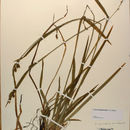Description
provided by eFloras
Culms densely tufted, ascending, lax or decumbent, 45–87 cm × 2–2.2 mm brownish. Leaves: basal sheaths; sheaths green, lighter toward base, 7–55 mm; blades ascending, green, corrugate, 19–52 cm × 3–16 mm, blades of overwintering leaves smooth abaxially. Inflorescences: peduncles of lateral spikes 0–15 cm; of terminal spike 0.2–4 cm; bracts 2.5–13 × 3–10 mm, blade of distal lateral spike linear. Spikes (3–)4(–5) per culm; lateral spikes erect, 12–27 × 2.7–3 mm; terminal spike linear-clavate, 15–21 × 2–2.7 mm, usually from sheath of distal lateral spike. Pistillate scales 2.7–3.1 × 1.9–2.3 mm, apex aristate to acute. Staminate scales obovate, 5.7–6.2 × 2.7–3 mm, margins hyaline and brownish, apex acute. Anthers 3–3.2 mm. Perigynia 7–12 per spike, scattered on proximal spikes, ratio of longer lateral spike length to perigynia number 1.9–3.4, aggregated on distal spikes, (22–)25–32-veined, linear, 4.6–6 × 1.8–2.3 mm; beak slightly concave at maturity, 0.5–1.8 mm. Achenes ellipsoid, 4.5–5 × 1.6–2 mm.
- license
- cc-by-nc-sa-3.0
- copyright
- Missouri Botanical Garden, 4344 Shaw Boulevard, St. Louis, MO, 63110 USA
Distribution
provided by eFloras
B.C.; Calif., Idaho, Oreg., Wash.
- license
- cc-by-nc-sa-3.0
- copyright
- Missouri Botanical Garden, 4344 Shaw Boulevard, St. Louis, MO, 63110 USA
Habitat
provided by eFloras
Moist, mixed deciduous-evergreen forests; 5–1000m.
- license
- cc-by-nc-sa-3.0
- copyright
- Missouri Botanical Garden, 4344 Shaw Boulevard, St. Louis, MO, 63110 USA
Comprehensive Description
provided by North American Flora
Carex hendersonii L. H. Bailey, Proe. Am. Acad 22: 115. 1886.
"Carex laxiflora var. planlaginea Boott" Olney; A. Gray, Proc. Am. Acad. 8: 407. 1872.
Loosely cespitose, the rootstocks slender, usually short, the clumps medium-sized, the culms 4-9 dm high, leafy throughout, erect or decumbent, stoutish, mostly central and phyllopodic, sharply triangular, scarcely winged, exceeding the leaves, roughened on the angles, brownish at base; sterile shoots elongate, conspicuous; leaves (not bracts) with well-developed blades 3-5 to a fertile culm, mostly towards the base, the blades 5-25 cm. long, 3-10 mm. wide, light-green, flat, thin, the midvein prominent on the upper surface and the two midlateral veins on the lower, roughened towards the apex; blades of the sterile culms more numerous, 2-5 dm. long, 4-15 mm. wide; sheaths enlarged upward, yellowish-brown-tinged at mouth, prolonged upward beyond base of blade and continuous with the ligule; staminate spike more or less peduncled, linear, 1.5-3 cm. long, 2-3 mm. wide, the scales oblong-obovate, acute to obtuse, whitish-hyaline with green or straw-colored 3-nerved center, usually more or less strongly brownish-red-tinged; pistillate spikes 2-4, erect, the upper two contiguous and little or not at all exsert-peduncled, the lower one or two widely separate, erect on slender, slightly roughened, elongate peduncles, all linear, 1-4 cm. long, 4-6 mm. wide, containing 5-12 alternate ascending perigynia, in few rows; lower bracts leaf -like with long, nearly smooth sheaths, the upper much reduced and from shorter than to exceeding the inflorescence; scales broadly obovate, mucronate, white-hyaline with 3-nerved green center, usually chestnut-browntinged, as wide as but much shorter than the perigynia; perigynia narrowly obovoid, not at all inflated, obtusely triangular below, more sharply so above, 5-6 mm. long, 2 mm. wide, many-nerved, the keels prominent, light-green or greenish-straw-colored, submembranaceous, glabrous, puncticulate, substipitate, long-tapering and spongy at base, tapering at apex into a straight beak nearly 1 mm. long, obliquely cut, minutely bidentate, hyaline-tipped; achenes obovoid, triangular with concave sides, filling the perigynium, 3 mm. long, 2 mm. wide, substipitate, brownish, more or less granular, short-apiculate, and jointed with the straight slender style; stigmas three, slender, reddish-brown; anthers 4 mm. long.
Type locality: Bogs at Portland, Oregon (L. F. Henderson).
Distribution: Damp woods in the Coast Ranges, from southwestern British Columbia to Sonoma County, California. (Specimens examined from British Columbia (including Vancouver Island) Washington, Oregon, northern California.)
- bibliographic citation
- Kenneth Kent Mackenzie. 1935. (POALES); CYPERACEAE; CARICEAE. North American flora. vol 18(5). New York Botanical Garden, New York, NY
Carex hendersonii: Brief Summary
provided by wikipedia EN
Carex hendersonii, also known as Henderson's sedge or carex de Henderson, is a tussock-forming species of perennial sedge in the family Cyperaceae. It is native to western parts of North America.
- license
- cc-by-sa-3.0
- copyright
- Wikipedia authors and editors

